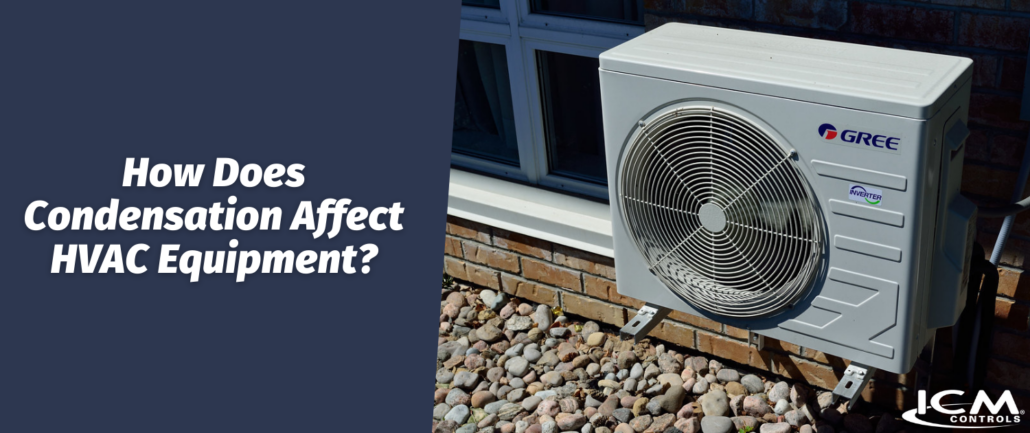Condensation occurs when moist, warm air comes into contact with a surface that is cooler than the air, causing the moisture in the air to turn into water droplets. This is a natural phenomenon that occurs when heating or cooling your home. Air conditioning removes heat from the indoor air, lowering the air temperature and reducing its ability to hold moisture (humidity). As a result, the excess moisture in the air can condense on the cooler surfaces of your home, such as windows, walls, or pipes. This is why you often see water droplets on the outside of a cold glass of water on a hot day; the same principle applies to the cool surfaces in your home.
When you heat a home during cold weather, the temperature inside the house becomes warmer than the outside. If the interior surfaces, like windows or walls, are colder than the indoor air, moisture in the indoor air can condense on these colder surfaces. This is common with single-pane windows, which tend to be cooler than the rest of the room, leading to condensation on the glass.
It’s Normal for Your HVAC to Produce Condensate
Condensation is a normal byproduct of the cooling process in air conditioning systems. As the condensation drips down, it collects in the drain pan and (if it’s properly maintained and not clogged) runs through the condensate drain line and out of your home. However, excessive condensation or a clogged drain line can lead to mold and mildew growth and even structural damage if drainage water is allowed to accumulate and puddle over time.
Condensation can also affect your HVAC equipment and its components. However, excess condensation, like sweating ducts and drips from outside the HVAC cabinet, indicates a problem with your unit and points to an HVAC issue that requires immediate service.
Ductwork and Insulation:
- Condensation inside ductwork can lead to moisture buildup, which can result in mold growth and deterioration of the duct material over time.
- Inadequate insulation or improperly installed insulation around ducts can allow condensation to form on the exterior of the ducts, reducing their energy efficiency and potentially causing water damage to surrounding areas.
Air Handlers and Evaporator Coils:
Condensation can form on the evaporator coils inside air handlers. If not properly managed, this moisture can lead to mold growth, reduced efficiency, and even equipment damage.
In some cases, condensation can affect the electrical components of the air handler, potentially causing shorts or other electrical problems.
Heat Exchangers:
Condensation can also form on heat exchangers in heating systems when warm combustion gases come into contact with cooler surfaces. This condensation can be acidic and cause corrosion, reducing the lifespan of the heat exchanger and potentially releasing harmful gases into the indoor air if the heat exchanger fails.
Air Quality:
Condensation can contribute to high humidity levels in HVAC systems if not properly controlled. Excess humidity can promote mold and bacteria growth, which can result in poor indoor air quality and potential health issues for occupants.
Preventing Damage from Condensation
Proper design, installation, and regular maintenance are essential to mitigate the adverse effects of condensation on HVAC equipment. This includes ensuring that ductwork is insulated correctly, drain lines are clear and functional, and coils are clean and well-maintained. Additionally, controlling indoor humidity levels through proper ventilation and dehumidification can help prevent condensation-related issues.
Regular HVAC maintenance, including cleaning, inspections, and preventative measures, is crucial to detect and address condensation-related problems before they lead to significant equipment damage or indoor air quality issues. If you don’t already have a regular maintenance contract with an HVAC provider in your area, it’s a smart idea to schedule two inspections per year – one in the spring prior to starting up your AC unit and one in the early fall before heating season begins. This should help to prevent costly repairs.
As a home or business owner, it’s important to regularly change your air filter every 30-90 days throughout the year. Check with your HVAC technician to find out how frequently he recommends for your system. During the summer months, when your AC is running regularly, establish a habit of cleaning and flushing your condensate line with diluted bleach or vinegar. It takes just a few minutes and will prevent mildew from growing and clogging the line. Your HVAC tech can show you how to do this between maintenance visits.
————————————————————————————————————————————————————————————————————————————————————–
ICM Controls manufactures both OEM and aftermarket products under its own brand names for HVAC, Electrical, pool & spa, marine, and recreational vehicle markets.
We manufacture a wide range of Surge Protection Devices, Line Voltage Monitors, Fan Blower Controls, Time Relays, Defrost Boards, and Universal Furnace Control Boards. We have worked closely with some of the world’s most renowned business giants for decades. To learn more, visit icmcontrols1.wpengine.com









